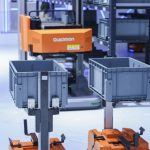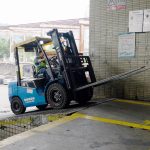Warehouses and supply chains are the backbone of our modern commercial environment, writes Steven Watson (pictured), UK Managing Director of Timewise Systems. However, the warehouse and supply chain sectors are grappling with a persistent labour shortage. As businesses scale and customer expectations continue to rise, many are under pressure to do more with less. Now, with customer expectations at an all time high, there’s frequently less time and often less labour available.
This has led operations teams to an indisputable conclusion. It’s no longer a question of if they invest in automation, but how to do it strategically. Across the industry, forward-thinking warehouse operators are looking to boost productivity, reduce errors and unlock efficiencies. The plot twist is that this needs to be achieved without becoming overly dependent on a workforce that’s increasingly difficult to recruit and retain. This is where smart technology steps in. Not only does smart technology offer a strategic way to streamline day-to-day operations, but it also supports long-term business performance.
Start with the right focus
There’s a common misconception that solving the labour challenge means introducing robotics or full-scale automation across the board. This couldn’t be further from the truth. In reality, the most effective transformations start with something far more targeted. This involves identifying the biggest friction points in your operation and deploying technology to solve them. That might involve replacing paper-based picking processes with voice-directed workflows, or implementing a warehouse system to manage task prioritisation in real time.
These kinds of changes don’t require a full system overhaul. They’re about smart, incremental improvements that make a measurable difference. When technology is introduced with clear objectives and measurable outcomes, the return on investment can be both quick and significant.
Reducing costs while improving performance
Labour shortages often lead to reactive decision-making, such as bringing in temporary workers at a premium, extending shifts or pushing existing teams beyond capacity. This may help in the short term, but it’s not sustainable. Technology helps break that cycle by optimising how work is planned, distributed and executed. By automating routine tasks and reducing manual errors, warehouses can achieve higher and more accurate output without burning out their workforce. More consistent performance leads to fewer missed deadlines, better use of available labour and tighter control over operational costs. In many cases, even a small tech-driven change can reduce labour costs by double-digit percentages.
Empowering your workforce
It’s important to stress that technology isn’t about replacing people. In fact, one of the major benefits technology brings to warehouses is its ability to empower them. When employees are equipped with intuitive, supportive tools, their jobs become easier, safer and more rewarding. Instead of spending time on repetitive manual tasks, they can focus on value-added work like quality control or exception handling. Smart technology also enables better communication, faster onboarding, and more flexibility in task management. For businesses struggling to attract and retain staff, this can be a significant advantage.

Steven Watson
From efficiency to customer satisfaction
At the heart of every warehouse operation is the customer. They may never see what happens on the warehouse floor, but they certainly feel the effects. Delays, stockouts or incorrect deliveries all chip away at trust. When warehouse systems are optimised, customers benefit from faster, more accurate fulfilment. That reliability builds reputation and repeat business, which is essential in today’s competitive market.
A strategic approach to change
The most successful warehouse operations don’t rush to automate everything overnight. They take a strategic approach; prioritising their most pressing challenges and selecting solutions that are scalable and sustainable. With the right planning and execution, it’s possible to navigate the labour shortage while strengthening every aspect of the operation. Smart investment in warehouse technology isn’t about plugging the gaps. Instead, it unlocks new levels of productivity and sets the foundation for future growth.
Steven Watson is the MD (UK) of Timewise Systems. Timewise is a provider of technology solutions that help warehouse and supply chain operations work smarter, faster and more efficiently.
similar news
The post Smarter Warehousing in a Labour-Short World appeared first on Logistics Business.


